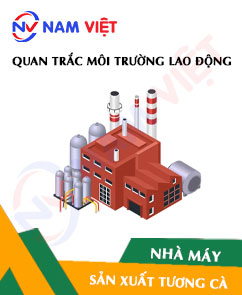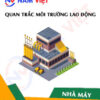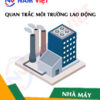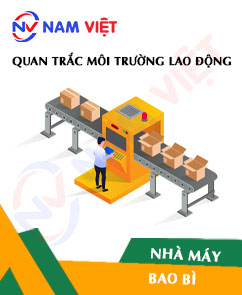Occupational environment monitoring at a ketchup manufacturing factory
99,000 ₫
Note: The above price is calculated for one sample, and the price may fluctuate depending on the area of the environment to be monitored and market movements. For more accurate pricing support, please refer to the price list or contact our consulting staff directly.
Monitoring the environment of a ketchup production factory is a session of collecting, analyzing, and evaluating workplace factors that may be harmful to workers’ health.
Table of Contents
Toggle1. Overview of Ketchup Production Factory
a. What is a ketchup production factory?
Factory producing ketchup is an industrial facility designed to manufacture and process products related to ketchup. Ketchup is a type of sauce made from tomatoes, commonly used in many dishes and fast foods.
In a ketchup production factory, the processing and packaging process is carried out to produce ketchup products with consistent quality and meet market demands.

b. Production stages in a ketchup production factory
The production stages in a ketchup production factory may include:
- Preparation and processing of raw materials:
- Select fresh, high-quality tomatoes and check their quality.
- Wash thoroughly and remove impurities and dirt.
- Tomato processing:
- Puree or crush tomatoes into liquid, mixture, or powder form.
- Cook tomatoes in large pots or cooking systems.
- Add ingredients and spices:
- Add salt, sugar, and other spices according to precise formulas and ratios.
- Mix thoroughly to ensure all components are dissolved.
- Cooking and flavoring:
- Cook the tomato mixture and other ingredients in large pots.
- Control temperature, time, and cooking techniques to achieve the desired flavor.
- Filtering and refining:
- Filter the tomato mixture to remove residues and create a smooth sauce.
- Refine the sauce to clean it and achieve the desired clarity.
- Packaging:
- Pour ketchup into jars, bottles, packets, or other packaging units.
- Seal the product and label it to ensure hygiene and traceability.
- Quality control:
- Conduct quality checks on the ketchup product, including taste, acidity, smoothness, clarity, and other quality parameters.

c. Types of machinery used in a ketchup production factory
In a ketchup production factory, various machines and equipment are used to increase efficiency and automate the production process. Below are some common machines in a ketchup production factory:
- Tomato washing and sorting machine: Used to wash and sort tomatoes, remove impurities, and cut off damaged parts.
- Tomato pureeing machine: Used to puree tomatoes into liquid or mixture form.
- Cooking pots: Large cooking pots are used to cook tomatoes and other ingredients during processing.
- Mixers: Used to mix ingredients and spices evenly during ketchup processing.
- Filtering machine: Used to remove residues and create a smoother sauce.
- Packaging machines: Automatic or semi-automatic machines are used to fill ketchup into jars, bottles, packets, or other packaging units, and carry out sealing and labeling.
- Quality control machines: Used to check taste, acidity, smoothness, and other quality parameters of the ketchup product.

d. Occupational diseases that workers in ketchup production factories may face
Workers in ketchup production factories may encounter some occupational diseases related to their work environment and tasks. Some common occupational diseases in the ketchup production industry include:
- Respiratory diseases: Workers may be exposed to steam, dust, and chemicals during processing, contributing to respiratory problems. Diseases such as pneumonia, asthma, sinusitis, and other lung issues may occur.
- Skin diseases: Exposure to materials during ketchup production may cause skin irritation, dermatitis, infections, and other skin-related problems.
- Eye diseases: Dust and chemicals in the work environment can irritate and damage eyes, causing issues such as conjunctivitis, eye pain, and dryness.
- Ear, nose, and throat diseases: Exposure to materials and polluted environments may irritate and harm the ear, nose, and throat system, causing infections, sinusitis, and sore throat.
- Spine and musculoskeletal disorders: Working in uncomfortable postures and handling heavy loads can cause spine and joint problems, such as back pain, spinal degeneration, and arthritis.
To protect workers’ health, occupational safety measures and safe working procedures should be implemented. Additionally, providing personal protective equipment, ensuring ventilation, and managing environmental waste are necessary measures to reduce the risk of occupational diseases.

e. Popular types of ketchup on the market
There are many popular types of ketchup on the market, each with its own characteristics and flavor. Below are some common types of ketchup:
- Regular ketchup: The basic type with sweet, sour, spicy, and salty flavors. Commonly used for seasoning, cooking, and as a condiment for Asian dishes.
- Black ketchup: Darker in color with a distinctive flavor. Usually made by cooking tomatoes for a long time to create a special taste.
- Honey-flavored ketchup: Made from tomatoes and infused with honey. It has a natural sweetness and is suitable for grilling, roasting, and cooking various dishes.
- Shrimp paste-flavored ketchup: Made from tomatoes and infused with shrimp paste, creating a unique and rich flavor. Often used in seafood dishes, stir-fried noodles, steamed mushrooms, and grilled dishes.
- Vegetarian ketchup: Made from plant-based ingredients with no animal components. Suitable for vegetarians and those following a plant-based diet.
- Onion ketchup: Made from tomatoes and onions, creating a rich and tasty flavor. Commonly used in traditional dishes like sandwiches and sticky rice.
- Spicy ketchup: Has a strong hot and spicy flavor. Often used in dishes that require heat, such as spicy stir-fried noodles, spicy sticky rice, and noodle or salad dishes.
2. Overview of Workplace Environmental Monitoring Services
a. What is workplace environmental monitoring in ketchup production factories?
Workplace environmental monitoring (or labor environment measurement) in ketchup production factories is the activity of collecting, assessing, and analyzing measured indicators of workplace environmental factors at ketchup production factories, in order to take timely measures, minimize environmental harm to workers’ health, and prevent occupational diseases. Workplace environmental monitoring is a mandatory requirement for ketchup production factories.
Workplace environmental monitoring plays a crucial role in caring for, protecting, and enhancing workers’ health because workers are the primary resource of the enterprise and directly generate profit. Workers frequently exposed to risk factors and occupational hazards exceeding permitted standards may suffer health impacts and develop occupational diseases.
REGISTER FOR WORKPLACE ENVIRONMENTAL MONITORING SERVICE
b. Nam Viet’s workplace environmental monitoring program
Nam Viet’s workplace environmental monitoring program is developed by monitoring engineers in the fields of occupational safety and environmental protection. Aiming to ensure workers’ health and safety, this program uses modern measurement methods to monitor air, water, and microclimatic, physical, and dust factors in the work environment. This is a crucial program for ensuring a safe working environment and protecting workers’ health.
Additionally, Nam Viet’s program plays an important role in researching and developing new solutions to improve workplace environmental quality. With the dedication and professionalism of its monitoring experts, Nam Viet’s exclusive monitoring program is becoming a breakthrough in occupational safety and environmental management in Vietnam.

c. Standardization in workplace measurement procedures
Standardization in Nam Viet’s workplace measurement procedures is essential for ensuring measurement result quality. To ensure accuracy and reliability, the program follows recognized standards and procedures of Ho Chi Minh City Department of Health. This ensures that collected data are highly reliable for assessing workplace conditions and making decisions to improve the work environment and protect worker health.
These standardized procedures also ensure that measurements are conducted by highly qualified monitoring experts with years of experience, enabling managers and specialists to trust Nam Viet’s results and make accurate, valuable decisions to protect workers’ health and the environment.
By applying standardization in workplace measurement procedures, Nam Viet demonstrates its commitment to ensuring a safe work environment and protecting workers’ health, while actively contributing to the development and improvement of occupational safety and environmental management in Vietnam.
d. Reporting results of ketchup production factory monitoring
Workplace environmental monitoring results are prepared according to Form 04 Appendix III issued with Decree 44/2016/ND-CP and made in two copies: one copy sent to the workplace that contracted the monitoring service and one copy retained by the organization performing the monitoring.
The retention period of workplace environmental monitoring results is unlimited according to legal regulations.

e. Frequency of workplace environmental monitoring according to legal regulations
According to Clause 2, Article 18 of the Law on Occupational Safety and Health 84/2015/QH13, employers must organize workplace environmental monitoring to assess harmful factors at least once a year.
f. Deadline for submitting workplace environmental monitoring results according to legal regulations
The deadline for submission is before December 31 each year. Enterprises of production facilities are required to submit workplace environmental monitoring reports to the local Department of Health where the production or business facility has its headquarters and where workers are employed.
When there are changes in technology, production processes, or when renovating or upgrading facilities that may introduce new hazards to workers’ health, enterprises must update occupational hygiene records regarding harmful factors that need workplace environmental monitoring.
g. Penalties for violations of workplace environmental monitoring by employers
According to Article 27 of Decree No. 12/2022/ND-CP dated January 17, 2022, regulating administrative penalties in labor, social insurance, and Vietnamese workers going abroad under contracts:
- Clause 2: Fines of 2,000,000 – 5,000,000 VND for employers who do not publicly disclose monitoring results to employees at the monitored workplace and at places where hazardous factors are checked, assessed, and managed immediately after obtaining workplace environmental monitoring results and assessments.
- Clause 3: Fines of 20,000,000 – 40,000,000 VND for employers who fail to conduct workplace environmental monitoring to control health hazards according to the law.
- Clause 4: Fines of 40,000,000 – 60,000,000 VND for employers who collaborate with monitoring organizations to commit fraud in environmental monitoring activities but not to the extent of criminal liability.
3. Harmful Environmental Factors for Workers in Ketchup Manufacturing Factories
Workers in ketchup manufacturing factories may be exposed to several harmful environmental factors. Below are the main factors:
- Spicy fumes and flavors: During ketchup processing, spicy fumes and flavors from ingredients such as garlic, onions, and chili may cause irritation to the eyes, nose, and respiratory system.
- Dust and fine particles: The grinding and processing of ketchup can generate dust and fine particles in the working environment. Inhalation can cause respiratory irritation and pneumonia.
- Chemicals: Some chemicals, such as preservatives, colorants, and acidity regulators, may be used in ketchup production. Exposure to these substances can cause skin, eye, and respiratory irritation.
- Temperature and humidity: The working environment in ketchup factories often has high temperature and humidity due to the cooking process. This can cause discomfort and affect workers’ health and well-being.
- Occupational accidents: Ketchup factories may face risks of occupational accidents, including cuts, slips, falls, injuries from machinery and equipment, or from moving ingredients during production.
REGISTER FOR OCCUPATIONAL ENVIRONMENT MONITORING SERVICE
4. Measures to Improve the Working Environment in Ketchup Manufacturing Factories
To improve the working environment in ketchup factories, the following measures can be applied:
- Ensure ventilation and exhaust systems: Install ventilation systems and exhaust fans to reduce temperature and humidity, and remove smoke, spicy fumes, and other irritants from the workspace.
- Use personal protective equipment (PPE): Provide employees with PPE such as safety goggles, masks, helmets, gloves, and chemical-resistant clothing to protect skin, eyes, respiratory system, and prevent harmful environmental impacts.
- Ensure machinery and equipment safety: Regularly inspect and maintain machinery and equipment to ensure safe operation and prevent occupational accidents. Guide employees on safe usage of machines and equipment.
- Maintain workplace hygiene: Keep the factory clean, especially areas in direct contact with ketchup. Ensure surfaces, tools, and equipment are properly sanitized to prevent bacteria and mold growth.
- Training and awareness of occupational safety: Provide regular safety training to employees to help them understand risks and preventive measures. Promote health and safety awareness and encourage reporting of workplace issues.
- Environmental waste management: Implement proper procedures to manage and dispose of environmental waste generated during ketchup production.
- Regularly conduct occupational environment monitoring in the factory, collect and analyze harmful factors, and adjust to reduce hazards to prevent occupational diseases for workers.
5. Benefits of Periodic Ketchup Factory Environment Monitoring
An Toan Nam Viet provides businesses with outstanding benefits when using occupational environment monitoring services according to Decree 44/2016/NĐ – CP on the management and control of harmful factors in the workplace affecting workers.
- Businesses can proactively control harmful factors in their workshops or factories.
- Receive advice and recommendations to minimize harmful factors and improve workplace environmental quality.
- Indirectly protect human resources, a key factor in business development.
- Reduce the impact of occupational diseases on health, minimizing future medical costs.
- Improved worker health leads to higher product quality and ensures consistent production output.
- Ensure compliance with labor safety regulations and avoid legal risks.
- Enhance credibility and professionalism, elevating the company’s brand.
An Toan Nam Viet’s environmental monitoring service is a solution to reduce occupational disease risks, contributing to a clean and high-quality working environment.

6. Nationwide Occupational Environment Monitoring Center
An Toan Nam Viet Occupational Environment Monitoring Center is a professional unit for supervising and measuring occupational environment quality across all provinces in Vietnam. With experienced monitoring specialists, the center uses modern measuring equipment to ensure accuracy and reliability.
Besides monitoring services, the center assists clients in planning, managing, and tracking workplace environmental issues. With the motto “customer-centric,” the center prioritizes client satisfaction and provides optimal solutions for businesses.
REGISTER FOR OCCUPATIONAL ENVIRONMENT MONITORING SERVICE
With investments in technology, equipment, and workforce, An Toan Nam Viet’s monitoring center has become a reputable unit in occupational environment monitoring in Ho Chi Minh City with the following objectives:
- We value our brand reputation and the quality of our services.
- We provide clients with the best and most suitable solutions.
- Alongside experienced Masters and Engineers, aiming to protect the environment and benefit businesses.
- Clients using An Toan Nam Viet monitoring services receive professional support from experts and the best cost advantages.
The occupational environment monitoring process at An Toan Nam Viet includes the following steps:
- Before monitoring, ensure all equipment is calibrated according to legal regulations.
- Follow the committed occupational environment monitoring procedures with the Department of Health.
- Report monitoring results honestly to employers.
- If results indicate unsafe conditions, An Toan Nam Viet will support remediation measures, and the workplace will:
- Implement measures to improve working conditions, minimizing harmful factor exposure and preventing occupational diseases.
- Organize health check-ups to detect occupational diseases early for workers in unsafe positions.
- Provide material compensation to workers according to labor law regulations.

7. Occupational Environment Monitoring Pricing
To help businesses conduct professional and effective occupational environment monitoring, An Toan Nam Viet provides a detailed price list for monitoring services with quality and reasonable costs.
- Our price list provides detailed information on all monitoring services offered, including costs for travel, measurement, analysis, and reporting. Clients can trust the accuracy and reliability of our monitoring reports.
- We commit to offering competitive and reasonable prices, while providing fast and professional consultation for all monitoring service inquiries.
- With An Toan Nam Viet’s monitoring price list, clients can easily select service packages suitable for their needs, ensuring maximum satisfaction with professional service quality.
No comments yet












Review Occupational environment monitoring at a ketchup manufacturing factory
There are no reviews yet.